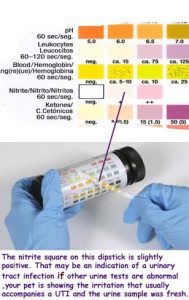Ron Hines DVM PhD
 See What Normal Blood & Urine Values Are
See What Normal Blood & Urine Values Are
 Causes Of Most Abnormal Blood & Urine Tests
Causes Of Most Abnormal Blood & Urine Tests
Nitrite In Your Pet’s Urine – Often An Indication Of A Urinary Tract Infection
Nitrites and nitrates are not the same thing. Nitrates form naturally in the environment from organic compounds that contain nitrogen. Vegetables are rich in nitrates, as are plant fertilizers. Nitrates contain a nitrogen atom and three oxygen atoms (NO3). Nitrites (NO2) are produced by bacterial fermentation of nitrates. They contain a nitrogen atom and two oxygen atoms. Nitrates, in small amounts, are beneficial. They are the source of NO1 or nitric oxide, a necessary compound in your pet’s body and in yours. Your dog and cat excretes excess urea in their urine. Urea also contains nitrogen. Some bacteria have the ability to break down urea liberating nitrites. So, when your pet’s urine is nitrite-positive, it means there are bacteria present somewhere in your dog or cat’s urinary tract. No all bacteria involved in UTIs have the ability to create nitrite. So, the lack of nitrite-positive urine is not firm evidence that your pet is free of a urinary tract infection.
Veterinarians usually screen dog and cat urine sample using a paper strip impregnated at different points with chemicals that change color when particular compounds are present in your dog and cat’s urine.
One of those compounds these tests looks for is nitrite. Nitrite is produced by certain bacteria. When the test is done correctly and your pet’s urine contains any nitrite, it is quite likely that the dog or cat has a bacterial urinary tract infection (UTI) – even when no bacteria or increased white blood cell numbers are seen.
Urine that sits too long at room temperature can give a false-positive nitrite reading due to bacterial contamination and growth while it sat. All urine samples that are obtained during a natural urination are contaminated with a few bacteria. Given time at room temperature, these bacteria will proliferate an alter several of the test strip results (another is pH). Out-of-date test strips or those left with the bottle cap off can give false negative or false positive results.
As I mentioned before, just because your pet’s urine tested negative for nitrite does not mean that your dog or cat does not have a urinary tract infection. Not all bacteria produce nitrite and some infections are too low grade to activate the test strip. If the leukocyte esterase (LE) portion of the strip was positive, if too many white blood cells were seen, if your pet is showing the typical signs of a urinary tract infection, or if your pet appears uncomfortable during urinating, it is a good idea to obtain a new clean sample (by catheter or needle) and culture the urine for bacteria – even if the nitrite portion of the test strip was negative. Bacterial culture of a sterile-collected urine sample from your pet is always a good idea – particularly if the problem repeats – just to be sure the right antibiotics have been chosen.
Complementary Tests:
Microscopic urine sediment examination, examination of the urine dipstick test strip used for a positive leukocyte esterase reaction, bacterial culture of your pet’s urine
DxMe
 Dear reader, Besides your donations, Visiting the products that you see displayed on this webpage also helps me pay the costs of keeping these articles on the Web. Best wishes, Ron Hines.
Dear reader, Besides your donations, Visiting the products that you see displayed on this webpage also helps me pay the costs of keeping these articles on the Web. Best wishes, Ron Hines.


